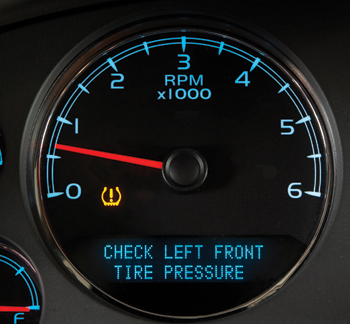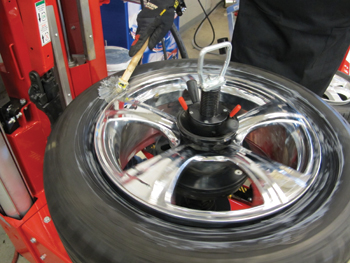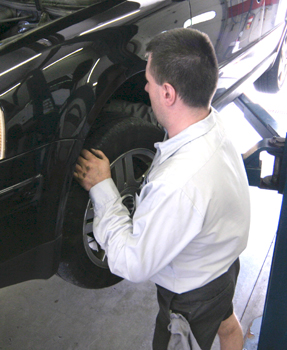
IF IT IS OUT, IT DOES NOT MEAN IT WILL STAY OUT
Even if the TPMS light is out when the vehicle leaves the bay, it does not mean the light will not come on later. Usually, this happens when the customer is driving home.
According to NHTSA TPMS rules, the TPMS system has 20 minutes to alert the driver there is a problem with the system like a damaged sensor from a mounting error. It may take the vehicle achieving a programmed speed or other event to perform a check of the sensors. This is why looking up the service procedure is required if you are performing any TPMS work and perform a little bit of quality control after the repair.
STEM ID
In the past three years, there has been a shift to rubber valve stems by Ford, GM and other manufacturers. At first glance, they look just like the valve stems from a non-TPMS vehicle. But, the cap will be longer and the stem will have more threads when compared to a conventional stem. This can help a tech avoid damaging a sensor by accidentally pulling the stem.
But regardless of the valve stem’s appearance, every 2008 and later vehicle has a TPMS system.

NO MORE SOAP AND WATER
Dry air and humid air have different properties. TPMS sensors are calibrated to deal with normal ranges of humidity found in the real world. But, if water is trapped inside the tire, it can change how the pressure relates to temperature.
Humidity or amount of moisture in the atmosphere changes the density of air. Surprisingly, the more moisture results in lower air density. At high humidity, the air density inside the tire decreases due to the reduced mass in a given volume. This will cause the TPMS light to come on as the tire cools or heats up.
If your shop is using a solution of soap and water to help in the mounting of tires, you could be leaving enough water inside the tire to change how the pressures react under changing temperatures. Use only mounting paste, the price of a tube is less than the cost of a comeback.
WAITER INFLATION
The pressure on the door jam placard is set for cold tires (setting for at least three hours). If you have a customer that is bring their vehicles in for an oil change and waiting, you should add 2-4 psi to the recommended placard inflation because the tires are hot. This can prevent the light from coming on after the tires cool down.
SPARE A MOMENT
Before you start a relearn procedure, check to see if the spare tire has a sensor. Often, the service information will make the relearn procedures generic so it can be used for a variety of models. Often the spare is the last sensor to be tested in a relearn procedure. This can be frustrating because it may seem like the vehicle will not relearn the new positions, when it is actually it is waiting to get information from the spare.

RECORD SENSOR IDS
If you are installing new tires, on some vehicles it is a good idea to record the sensor ID numbers and positions before the new tires are mounted. Some vehicles including Nissan, Toyota and Honda vehicles require that the sensor IDs be entered into the TPMS module through the DLC. This can really save time if something goes wrong during the relearn process and a sensor is not showing up in the memory.
INVEST IN TRAINING
Training is one of the most important investments you can make for two reasons. First, it can prevent damage to sensors and lost productivity trying to diagnosis a relearn problem. Second, it prevents you from sending a customer to the dealer where they could be lost forever.
TPMS is always changing so constant training is required to keep up with new systems and sensors.
STORAGE MODE FRUSTRATION
Technicians may become frustrated by new sensors stuck in storage or “super” sleep mode. Manufacturers of sensors are putting sensors in this mode to increase the shelf life of sensors by conserving the battery. To wake up a new sensor, it may require a rapid deflation or driving. Check the service information or the sensor’s manufacturer information.
BE PATIENT
When a relearn process is started, vehicles want only one sensor talking at a time. Sometimes, the sensors are active and sending out signals because the vehicle was repositioned or there is radio interference.
For the sensors to go into a sleep mode, the car has to be still for a programmed amount of time.
If you are having a difficult time with a relearn procedure, let the sit for 20 minutes. This should put the sensors into sleep mode. This allows the sensors to be turned on one at a time so the IDs and positions can read by the TPMS system.
CHUCK THE CHUCK
If you only work on light vehicles, the long-style air chuck should not be in your shop. These chucks can damage aluminum valve stems because they can create enough leverage to bend or break the stem.










